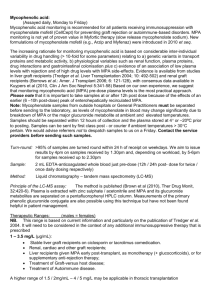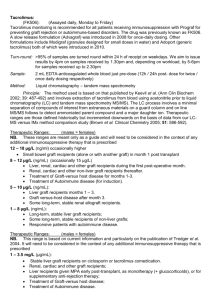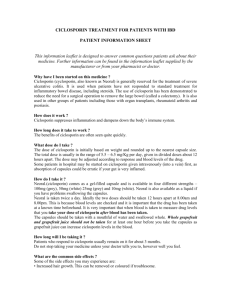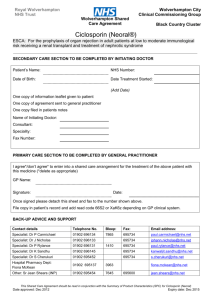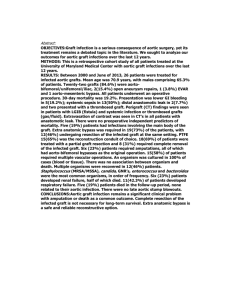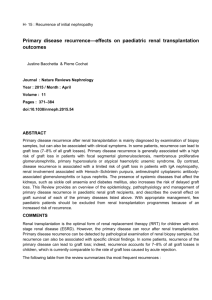Ciclosporin
advertisement
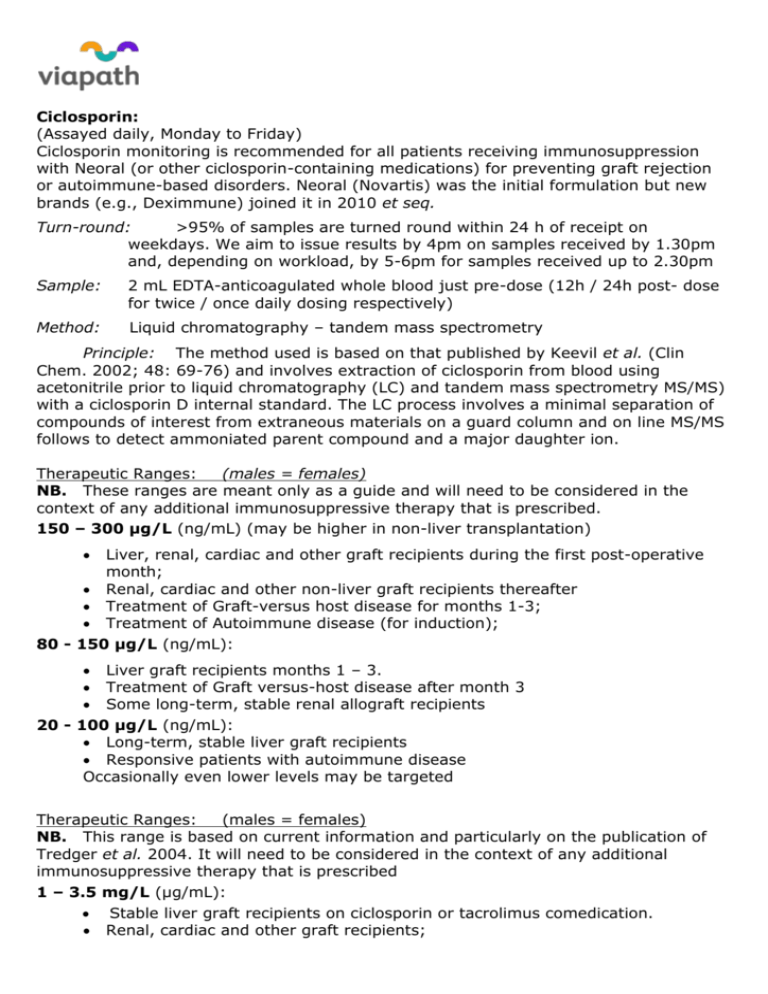
Ciclosporin: (Assayed daily, Monday to Friday) Ciclosporin monitoring is recommended for all patients receiving immunosuppression with Neoral (or other ciclosporin-containing medications) for preventing graft rejection or autoimmune-based disorders. Neoral (Novartis) was the initial formulation but new brands (e.g., Deximmune) joined it in 2010 et seq. Turn-round: >95% of samples are turned round within 24 h of receipt on weekdays. We aim to issue results by 4pm on samples received by 1.30pm and, depending on workload, by 5-6pm for samples received up to 2.30pm Sample: 2 mL EDTA-anticoagulated whole blood just pre-dose (12h / 24h post- dose for twice / once daily dosing respectively) Method: Liquid chromatography – tandem mass spectrometry Principle: The method used is based on that published by Keevil et al. (Clin Chem. 2002; 48: 69-76) and involves extraction of ciclosporin from blood using acetonitrile prior to liquid chromatography (LC) and tandem mass spectrometry MS/MS) with a ciclosporin D internal standard. The LC process involves a minimal separation of compounds of interest from extraneous materials on a guard column and on line MS/MS follows to detect ammoniated parent compound and a major daughter ion. Therapeutic Ranges: (males = females) NB. These ranges are meant only as a guide and will need to be considered in the context of any additional immunosuppressive therapy that is prescribed. 150 – 300 µg/L (ng/mL) (may be higher in non-liver transplantation) Liver, renal, cardiac and other graft recipients during the first post-operative month; Renal, cardiac and other non-liver graft recipients thereafter Treatment of Graft-versus host disease for months 1-3; Treatment of Autoimmune disease (for induction); 80 - 150 µg/L (ng/mL): Liver graft recipients months 1 – 3. Treatment of Graft versus-host disease after month 3 Some long-term, stable renal allograft recipients 20 - 100 µg/L (ng/mL): Long-term, stable liver graft recipients Responsive patients with autoimmune disease Occasionally even lower levels may be targeted Therapeutic Ranges: (males = females) NB. This range is based on current information and particularly on the publication of Tredger et al. 2004. It will need to be considered in the context of any additional immunosuppressive therapy that is prescribed 1 – 3.5 mg/L (µg/mL): Stable liver graft recipients on ciclosporin or tacrolimus comedication. Renal, cardiac and other graft recipients; Liver recipients given MPA early post-transplant, as monotherapy (+ glucocorticoids), or for supplementary anti-rejection therapy; Treatment of Graft-versus host disease; Treatment of Autoimmune disease. A higher range of 1.5 / 2mg/mL – 4 / 5 mg/L may be applicable in thoracic transplantation Wider Issues Rationale for Immunosuppressive Drug Monitoring Immunosuppressive drugs require monitoring because they act within a narrow range of concentrations and show large inter-individual differences in drug handling and efficacy which make standard dosing regimens impractical. Therapy aims to suppress the immune system sufficiently to prevent graft rejection or autoimmune disease but without either acute toxicity (e.g., renal or gastrointestinal damage) or the increased generic risks of infection or malignancy. IDM provides the most valuable method for regulating dosage in these circumstances and because no real time measurement of “immunosuppression” exists. The principle is to adjust dosage on the basis of standardised drug level measurements that can be targeted to a therapeutic range appropriate for the individual patient. Such adjustments must be made in conjunction with clinical information and other laboratory test results. IDM therapeutic ranges may vary with: the indication for drug therapy (reflecting disease or transplant history). time after the operation. co-therapy with other immunosuppressive agents. The customary single blood sample used for monitoring is the trough drug level, determined just prior to dosage and at a constant interval from the time of the previous dose. Because this trough blood level may correlate poorly with total drug exposure, measurements at alternative times e.g., two hours after dosing with Neoral (ciclosporin) – the C2 level – may also be used. This C2 level is suggested to show an improved estimate of total drug exposure but may be more difficult to obtain accurately if dosage or phlebotomy times vary. Therapeutic ranges are higher for C2 than for trough drug levels because drug levels peak around 2 h (the IDM service providers can supply additional information). Immunosuppressive drug levels may also be profoundly affected by: co-medication – especially cytochrome P450 inducers and inhibitors for tacrolimus, ciclosporin sirolimus and everolimus (e.g., rifampicin, corticosteroids and antifungal or antiviral agents) and antiviral co-therapy (e.g. ganciclovir, aciclovir), oral antibiotics and changing ciclosporin or tacrolimus levels (or inter-conversion) for mycophenolate; organ function - (especially liver function for tacrolimus and ciclosporin, and renal function for mycophenolate); gastrointestinal dysfunction and haemodynamic instability; hypoalbuminaemia and low haematocrit – increasing free drug levels (and often toxicity); genetic variability between individuals e.g., in the expression of cytochrome P4503A or p-glycoprotein for tacrolimus, ciclosporin or sirolimus, and of UDPglucuronyltransferase (UDPGT) 1A8/9 for mycophenolate In addition to use as an immunosuppressant, everolimus is being used as an antitumour drug and has been licensed for use in treating advanced renal cell carcinoma with the alternate trade name of Afinitor. Currently there is no information available on a suitable therapeutic range for these effects. Frequency of IDM testing The frequency at which IDM is performed generally decreases with time after transplant. It is rarely necessary to monitor levels more than three times weekly e.g., Monday, Wednesday and Friday because the half-lives of the immunosuppressants exceed 12h. Consequently, drug levels will not re-equilibrate for 2-3 days after changes in dosage. However, immediately after transplantation, daily monitoring may be required in unstable (especially paediatric) patients but the frequency may decrease to once three or six monthly in long-term stable patients. The frequency of testing should be determined by any changes in likely modulators of drug levels, that is: if immunosuppressive drug dosage is increased or decreased on clinical grounds; if the formulation of the drug is changed e.g., Prograf to Advagraf / Modigraf / Adoport, Neoral to Deximmune, CellCept to Arzip / Myfenax if acute graft rejection is diagnosed; if any other type of graft dysfunction occurs or is suspected; if drug-related side-effects are detected (e.g., nephro- or neurotoxicity for tacrolimus or ciclosporin, gastrointestinal disturbance for mycophenolate); if co-medication affecting drug levels is introduced, tapered or withdrawn; if liver or renal function additionally deteriorates or improves; if non-compliance is suspected; if diarrhoea or persistent severe gastrointestinal dysfunction occurs. The examination of drug profiles during a dosage interval may be a valuable adjunct to conventional trough level monitoring. The additional information available from these pharmacokinetic studies may reveal unexpected abnormalities in the rate and extent of drug absorption and disposition.
